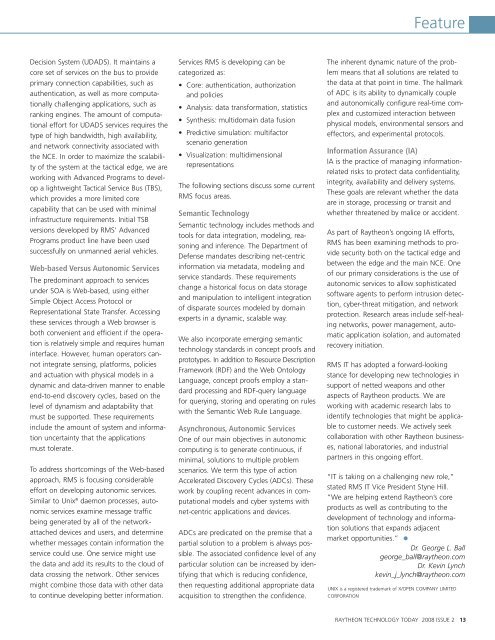2008 Issue 2 - Raytheon
2008 Issue 2 - Raytheon
2008 Issue 2 - Raytheon
You also want an ePaper? Increase the reach of your titles
YUMPU automatically turns print PDFs into web optimized ePapers that Google loves.
Decision System (UDADS). It maintains a<br />
core set of services on the bus to provide<br />
primary connection capabilities, such as<br />
authentication, as well as more computationally<br />
challenging applications, such as<br />
ranking engines. The amount of computational<br />
effort for UDADS services requires the<br />
type of high bandwidth, high availability,<br />
and network connectivity associated with<br />
the NCE. In order to maximize the scalability<br />
of the system at the tactical edge, we are<br />
working with Advanced Programs to develop<br />
a lightweight Tactical Service Bus (TBS),<br />
which provides a more limited core<br />
capability that can be used with minimal<br />
infrastructure requirements. Initial TSB<br />
versions developed by RMS’ Advanced<br />
Programs product line have been used<br />
successfully on unmanned aerial vehicles.<br />
Web-based Versus Autonomic Services<br />
The predominant approach to services<br />
under SOA is Web-based, using either<br />
Simple Object Access Protocol or<br />
Representational State Transfer. Accessing<br />
these services through a Web browser is<br />
both convenient and efficient if the operation<br />
is relatively simple and requires human<br />
interface. However, human operators cannot<br />
integrate sensing, platforms, policies<br />
and actuation with physical models in a<br />
dynamic and data-driven manner to enable<br />
end-to-end discovery cycles, based on the<br />
level of dynamism and adaptability that<br />
must be supported. These requirements<br />
include the amount of system and information<br />
uncertainty that the applications<br />
must tolerate.<br />
To address shortcomings of the Web-based<br />
approach, RMS is focusing considerable<br />
effort on developing autonomic services.<br />
Similar to Unix ® daemon processes, autonomic<br />
services examine message traffic<br />
being generated by all of the networkattached<br />
devices and users, and determine<br />
whether messages contain information the<br />
service could use. One service might use<br />
the data and add its results to the cloud of<br />
data crossing the network. Other services<br />
might combine those data with other data<br />
to continue developing better information.<br />
Services RMS is developing can be<br />
categorized as:<br />
Core: authentication, authorization<br />
and policies<br />
Analysis: data transformation, statistics<br />
Synthesis: multidomain data fusion<br />
Predictive simulation: multifactor<br />
scenario generation<br />
Visualization: multidimensional<br />
representations<br />
The following sections discuss some current<br />
RMS focus areas.<br />
Semantic Technology<br />
Semantic technology includes methods and<br />
tools for data integration, modeling, reasoning<br />
and inference. The Department of<br />
Defense mandates describing net-centric<br />
information via metadata, modeling and<br />
service standards. These requirements<br />
change a historical focus on data storage<br />
and manipulation to intelligent integration<br />
of disparate sources modeled by domain<br />
experts in a dynamic, scalable way.<br />
We also incorporate emerging semantic<br />
technology standards in concept proofs and<br />
prototypes. In addition to Resource Description<br />
Framework (RDF) and the Web Ontology<br />
Language, concept proofs employ a standard<br />
processing and RDF-query language<br />
for querying, storing and operating on rules<br />
with the Semantic Web Rule Language.<br />
Asynchronous, Autonomic Services<br />
One of our main objectives in autonomic<br />
computing is to generate continuous, if<br />
minimal, solutions to multiple problem<br />
scenarios. We term this type of action<br />
Accelerated Discovery Cycles (ADCs). These<br />
work by coupling recent advances in computational<br />
models and cyber systems with<br />
net-centric applications and devices.<br />
ADCs are predicated on the premise that a<br />
partial solution to a problem is always possible.<br />
The associated confidence level of any<br />
particular solution can be increased by identifying<br />
that which is reducing confidence,<br />
then requesting additional appropriate data<br />
acquisition to strengthen the confidence.<br />
Feature<br />
The inherent dynamic nature of the problem<br />
means that all solutions are related to<br />
the data at that point in time. The hallmark<br />
of ADC is its ability to dynamically couple<br />
and autonomically configure real-time complex<br />
and customized interaction between<br />
physical models, environmental sensors and<br />
effectors, and experimental protocols.<br />
Information Assurance (IA)<br />
IA is the practice of managing informationrelated<br />
risks to protect data confidentiality,<br />
integrity, availability and delivery systems.<br />
These goals are relevant whether the data<br />
are in storage, processing or transit and<br />
whether threatened by malice or accident.<br />
As part of <strong>Raytheon</strong>’s ongoing IA efforts,<br />
RMS has been examining methods to provide<br />
security both on the tactical edge and<br />
between the edge and the main NCE. One<br />
of our primary considerations is the use of<br />
autonomic services to allow sophisticated<br />
software agents to perform intrusion detection,<br />
cyber-threat mitigation, and network<br />
protection. Research areas include self-healing<br />
networks, power management, automatic<br />
application isolation, and automated<br />
recovery initiation.<br />
RMS IT has adopted a forward-looking<br />
stance for developing new technologies in<br />
support of netted weapons and other<br />
aspects of <strong>Raytheon</strong> products. We are<br />
working with academic research labs to<br />
identify technologies that might be applicable<br />
to customer needs. We actively seek<br />
collaboration with other <strong>Raytheon</strong> businesses,<br />
national laboratories, and industrial<br />
partners in this ongoing effort.<br />
“IT is taking on a challenging new role,”<br />
stated RMS IT Vice President Styne Hill.<br />
“We are helping extend <strong>Raytheon</strong>’s core<br />
products as well as contributing to the<br />
development of technology and information<br />
solutions that expands adjacent<br />
market opportunities.”<br />
Dr. George L. Ball<br />
george_ball@raytheon.com<br />
Dr. Kevin Lynch<br />
kevin_j_lynch@raytheon.com<br />
UNIX is a registered trademark of X/OPEN COMPANY LIMITED<br />
CORPORATION<br />
RAYTHEON TECHNOLOGY TODAY <strong>2008</strong> ISSUE 2 13
















